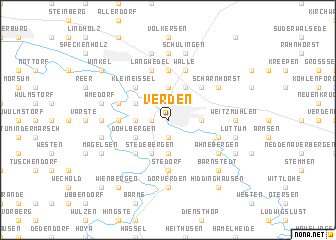 |
| Interior of German 18th century home |
As was discussed in the previous post, our ancestor, Johann Hinrich Spoering, (1759-1811), an oldest son, inherited Farm 5, Stedebergen.
Johann, born on Farm 5, Stedebergen, on October 10, 1759, was baptized on October 13 at St. Andreas Lutheran Church, Verden.
He later married Anne
Lucie Burdorf,
the daughter of Herman
Heinrich and Anne Mette
(Clason) Burdorf. Anne was from the village of Geestefeld, which was about 2.5 km. south of Stedebergen. Anne and Johann Hinrich married on October 29, 1784, again at St. Andreas. Anne, born on February 28, 1766, was about 7 years younger than her husband.

A house, in those days, would have the horse bays and the barn at one end and the living quarters at the other end. A Low German timbered house is shown here. Perhaps their home was more humble, we do not know.
Although a woman could inherit a farm, under no circumstances was she allowed to manage the farm. So there was often pressure to marry or the daughter could hire someone as an interim manager until she found someone to marry or a son was old enough to do the job. According to my fellow researcher, Lydia, "It was considered unseemly in every possible way for a woman to run a farm on her own, and why you never see a single woman running one of our north German farms."
So, again, a guess would be that the second marriage of Mr. Wendte and his first wife's sister, Anna Dorothea, was one of convenience rather than romance.
The other seven children and siblings of the inheritor were: Johann Heinrich Friedrich (1788-1838), Herman Wilhelm (1790-1850), Ilse Mette (1793 - 1849), Marie Gesche Adelheit (1795-1796), Jacob Hinrich Diedrich (1798-1849), Jacob Wilhelm (1803 - ?), and my direct relative, the youngest son, Jacob Friedrich, discussed in a previous blog.




